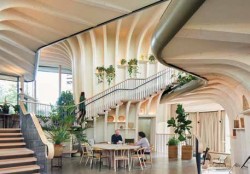Recently winning the ‘Winner of Winners’ Award at the Structural Timber Awards, Maggie’s Leeds once again proved that timber provides a stylish, contemporary and natural feel to a healthcare environment.
As many know, Maggie’s is a charity providing support for people affected by cancer and gives free practical and emotional support for people with cancer and their friends and families. It commissioned Heatherwick Studio to create its new centre on the campus of St James’s University Hospital in Leeds. Drawing upon the philosophy of Maggie's and the belief that great design can help people feel better, Maggie's Leeds uses several ‘healthy’ materials and energy saving techniques.
Set in the midst of medical buildings, the site was one of few green spaces left on the campus. The 462sq m centre is designed as a group of three largescale planters, built on a sloped site. The base of each planter encloses a distinct private counselling room for visitors to meet or spend time by themselves, while the areas between offer relaxed and approachable social spaces for group conversation and activities.
As well as serving 110 visitors a day, the studio wanted the centre to preserve the hospital’s only green space by making it more accessible and enjoyable. The site was the last patch of greenery at the hospital – a grassy hill next to the car park, bounded by roads on two sides and surrounded by large buildings. The sixmetre difference in level across the site would typically dictate a building dug into the slope but instead, the structure follows its natural contours, so that at the highest point, visitors have views of the Yorkshire Dales and a connection with the world beyond the hospital. The team designed a structure that could be built offsite and assembled quickly on a concrete slab and retaining wall, with minimal disruption.
1 The prefabricated insulated timber cassettes were manufactured in Switzerland and fixed together on-site in just eight weeks. These are supported by glulam fins, whose modulations give the feeling of trunks rising up from the ground to support the rooftop gardens overhead. The centre’s interior explores everything that is often missed in healing environments: natural and tactile materials, soft lighting, and a variety of spaces designed to encourage social opportunities as well as quiet contemplation. The studio also designed two tables, inspired by the building's timber fins and built from cork and engineered beech timber, which reside in the centre’s heart.
To read full article, go to Offsite Magazine issue 27!









